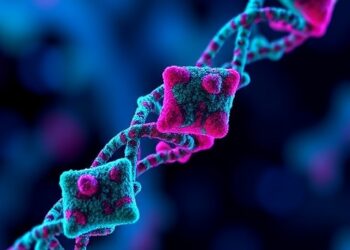BOSTON—Exposure to increased neighborhood violence has the power to change the glucocorticoid receptor (GR) for the stress hormone, cortisol, which may influence the aggressiveness of lung cancer, according to data presented Sunday at ENDO 2024, the Endocrine Society’s annual meeting in Boston, Mass.
“This research uncovers a previously unknown link between exposure to neighborhood violence, GR and lung tumor aggressiveness that can help us understand and fix the lung cancer health disparity seen in Black men” said Hannah Heath, B.S., a graduate research assistant at the University of Illinois at Urbana-Champaign in Urbana, Ill.
For this study conducted in Chicago, Heath and the research team found that Black men were more likely to live in neighborhoods with high levels of violent crime and have greater cortisol levels in their hair. This chronic stress, Heath explained, compelled the researchers to investigate how the GR impacted gene expression that regulates how aggressive a tumor will grow.
They collected lung tumor and healthy lung tissue samples from 15 Black and non-Black patients living in Chicago. Residential zip codes and police record data were used to determine which patients were living in neighborhoods with high, mid and low levels of violent crime.
Among the tests performed, Heath and colleagues performed Cleavage Under Targets & Release Using Nuclease (CUT&RUN), a new technology that can be used to pinpoint regions of DNA that GR binds to.
“We found that genes correlated with exposure to neighborhood violence were associated with pathways involved in cortisol signaling and increased tumor aggressiveness,” Heath said. “When we looked at the spatial expression of these cortisol-signaling and tumor aggressiveness genes, we found regions within tumor samples from high-violence neighborhoods that had elevated expression of these genes.”
They did not find these regions among patients with tumors who lived in low-violence neighborhoods. Furthermore, exposure to neighborhood violence led to the GR binding in regions of DNA that promotes a more aggressive lung tumor–an area it does not typically bind to.
“We hope this research will lead to larger studies that will ultimately be used to guide the addition of the neighborhood environment as a lung cancer screening eligibility parameter,” Heath said. “Currently, these parameters heavily focus on smoking habits. However, because Black men smoke less, they are often not eligible for screening, resulting in Black men being screened less and diagnosed later than white men.”
###
Endocrinologists are at the core of solving the most pressing health problems of our time, from diabetes and obesity to infertility, bone health, and hormone-related cancers. The Endocrine Society is the world’s oldest and largest organization of scientists devoted to hormone research and physicians who care for people with hormone-related conditions.
The Society has more than 18,000 members, including scientists, physicians, educators, nurses and students in 122 countries. To learn more about the Society and the field of endocrinology, visit our site at www.endocrine.org. Follow us on Twitter at @TheEndoSociety and @EndoMedia.
BOSTON—Exposure to increased neighborhood violence has the power to change the glucocorticoid receptor (GR) for the stress hormone, cortisol, which may influence the aggressiveness of lung cancer, according to data presented Sunday at ENDO 2024, the Endocrine Society’s annual meeting in Boston, Mass.
“This research uncovers a previously unknown link between exposure to neighborhood violence, GR and lung tumor aggressiveness that can help us understand and fix the lung cancer health disparity seen in Black men” said Hannah Heath, B.S., a graduate research assistant at the University of Illinois at Urbana-Champaign in Urbana, Ill.
For this study conducted in Chicago, Heath and the research team found that Black men were more likely to live in neighborhoods with high levels of violent crime and have greater cortisol levels in their hair. This chronic stress, Heath explained, compelled the researchers to investigate how the GR impacted gene expression that regulates how aggressive a tumor will grow.
They collected lung tumor and healthy lung tissue samples from 15 Black and non-Black patients living in Chicago. Residential zip codes and police record data were used to determine which patients were living in neighborhoods with high, mid and low levels of violent crime.
Among the tests performed, Heath and colleagues performed Cleavage Under Targets & Release Using Nuclease (CUT&RUN), a new technology that can be used to pinpoint regions of DNA that GR binds to.
“We found that genes correlated with exposure to neighborhood violence were associated with pathways involved in cortisol signaling and increased tumor aggressiveness,” Heath said. “When we looked at the spatial expression of these cortisol-signaling and tumor aggressiveness genes, we found regions within tumor samples from high-violence neighborhoods that had elevated expression of these genes.”
They did not find these regions among patients with tumors who lived in low-violence neighborhoods. Furthermore, exposure to neighborhood violence led to the GR binding in regions of DNA that promotes a more aggressive lung tumor–an area it does not typically bind to.
“We hope this research will lead to larger studies that will ultimately be used to guide the addition of the neighborhood environment as a lung cancer screening eligibility parameter,” Heath said. “Currently, these parameters heavily focus on smoking habits. However, because Black men smoke less, they are often not eligible for screening, resulting in Black men being screened less and diagnosed later than white men.”
###
Endocrinologists are at the core of solving the most pressing health problems of our time, from diabetes and obesity to infertility, bone health, and hormone-related cancers. The Endocrine Society is the world’s oldest and largest organization of scientists devoted to hormone research and physicians who care for people with hormone-related conditions.
The Society has more than 18,000 members, including scientists, physicians, educators, nurses and students in 122 countries. To learn more about the Society and the field of endocrinology, visit our site at www.endocrine.org. Follow us on Twitter at @TheEndoSociety and @EndoMedia.




